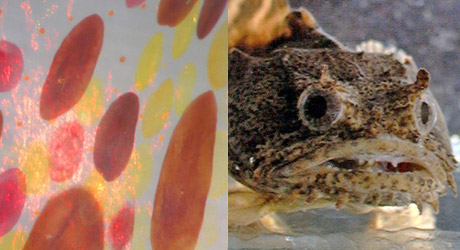MBL Announces New Program in the Study of Vision, Balance, and Hearing

FOR IMMEDIATE RELEASE: July 17, 2012
Contact: Diana Kenney, Marine Biological Laboratory, 508-289-7139; dkenney@mbl.edu
WOODS HOLE, MASS.—The Marine Biological Laboratory (MBL) announces the formation of a new program to capitalize on its many strengths in sensory biology—especially research into vision, balance, and hearing.
The new Program in Sensory Physiology and Behavior (PSPB) takes advantage of a unique combination of resources at the MBL to study how aquatic animals (squid, fishes, turtles, etc.) receive and neurologically process sensory information. This research has past and potential applications in many arenas, including treatments for human balance and hearing disorders and biotechnology innovations.
 Left: MBL research is aimed at the development of biomaterials that mimic the camouflage abilities of squid skin. This image shows the light-reflecting organs in squid skin -- chromatophores (large brown, red, and yellow structures) and iridophores (pink iridescent splotches). Photo by Lydia Mäthger. Right: Much of what we know about the sense organs in the inner ear that govern balance and equilibrium, and disorders of those organs such as vertigo and Ménière’s disease, have derived from MBL studies in the toadfish. Photo by David Remsen.
Left: MBL research is aimed at the development of biomaterials that mimic the camouflage abilities of squid skin. This image shows the light-reflecting organs in squid skin -- chromatophores (large brown, red, and yellow structures) and iridophores (pink iridescent splotches). Photo by Lydia Mäthger. Right: Much of what we know about the sense organs in the inner ear that govern balance and equilibrium, and disorders of those organs such as vertigo and Ménière’s disease, have derived from MBL studies in the toadfish. Photo by David Remsen.The program builds on the growth and success of existing laboratories in the MBL’s Marine Resources facility, as well as long-time strengths in sensory biology and neuroscience in the MBL’s Whitman Center, Grass Laboratory, and summer courses. It also capitalizes on the MBL’s renowned expertise and facilities for raising and maintaining aquatic organisms, and for high-level microscopy and imaging.
“This is a very exciting time in sensory biology, with links from molecules and cells to brains and whole behaviors and ecology,” says MBL Senior Scientist Roger Hanlon, director of the new program. “The integration and interpretation of sensory information guides the lives of all animals and humans. There are many key questions in basic and applied sensory science to be addressed.”
MBL Senior Scientist Stephen Highstein is associate director of the PSPB. Other core members include MBL scientists Alan Kuzirian and Lydia Mäthger, as well as active collaborators from nine other institutions.
“Research on any of the sensory systems—touch, smell, taste as well as hearing, vision, and balance—fits into our program,” says Highstein. “We especially encourage collaborations with people who take advantage of the unique resources at the MBL, and the marine organisms we can obtain. There is a lot to be learned from them.”
A central goal of the PSPB is to synergize the many MBL activities in sensory biology/neuroscience into a cohesive group with extensive intellectual exchange and a commitment to scientific discovery. This will be accomplished through several channels, including seminars, investigator and student exchanges year-round, collaborative research, and a bioinformatics and outreach component. The program will also provide a career path at MBL for young scientists conducting sensory-related research.
“We are forming a strong link between the MBL’s resident laboratories in sensory biology and its summer activities in this field, which have had a strong impact in the neurosciences,” says Hanlon.
— ### —
The Marine Biological Laboratory (MBL) is dedicated to scientific discovery and improving the human condition through research and education in biology, biomedicine, and environmental science. Founded in 1888 in Woods Hole, Massachusetts, the MBL is an independent, nonprofit corporation.